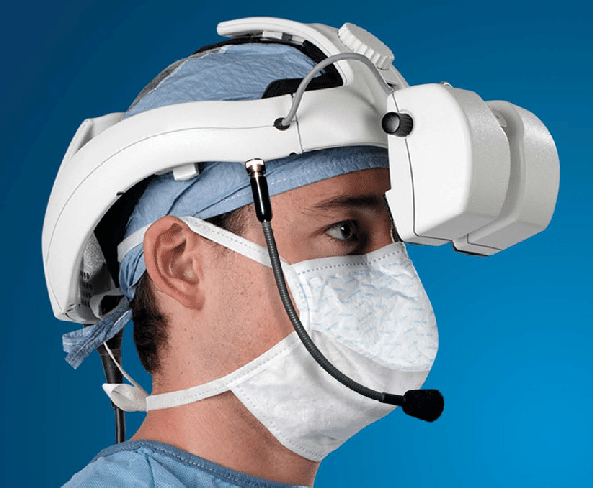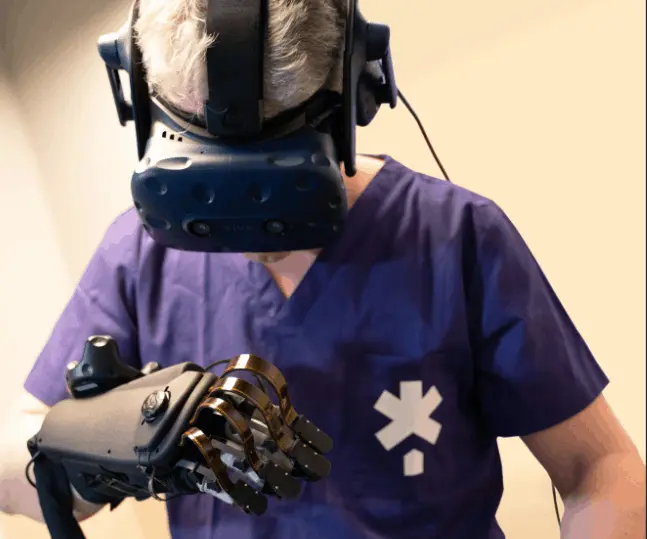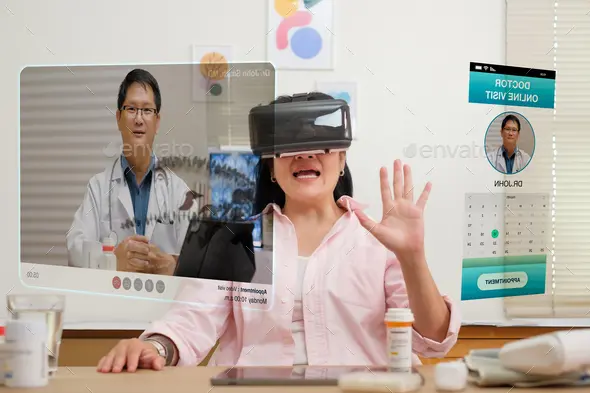The stethoscope was an innovation by Dr. René Laennec at a Paris Hospital, as he was uncomfortable about placing his ear on a female patient’s chest to listen to her heart sounds. Medical science has come a long way from then, and now you can visualize the inside of a heart, thanks to virtual reality technology in healthcare.
There is increasing pressure on healthcare professionals to provide quality service and improve healthcare outcomes, especially in the post-COVID world. Virtual reality in healthcare may just be the innovation that helps doctors and other professionals transform healthcare delivery. Let’s explore the potential of these technologies to drive transformation in patient management and enhance health outcomes.
Virtual reality in the medical field is simplifying the lives of doctors, other healthcare professionals, students, and patients. First introduced in the 1960s in military trials, virtual simulations were used for public trials two decades later. Today, its scope has widened to include everything from diagnosis to treatment and beyond. VR is used in various disciplines like mental health, pediatrics, orthopedics, surgery, and dentistry.
VR in healthcare is not meant to replace human doctors; instead, it’s intended to create an additional dimension of healthcare, allowing patients to communicate better and receive enhanced care. It can be especially helpful in training new doctors and surgeons, empowering them to discharge their duties more effectively.
Healthcare professionals use a wide variety of VR-based medical equipment to offer customized, superior care to patients. User-friendly and robust, VR-driven medical equipment enables the simulation of actual scenarios that deliver invaluable insights into symptoms and concerns.
VR in the healthcare industry provides immersive experiences to patients, especially mental health patients, children, and those in rehabilitation. Visualization offers more comfort and reassures patients better.
There is tremendous innovation in the health industry, with technology being increasingly used to enable healthcare professionals and patients to improve outcomes. Applications of virtual reality used in healthcare are numerous. Some of them are virtual examinations of patients before surgical procedures, virtual sensory tests for patients with weak muscles, and training medical staff with simulations. The hardware is continuously evolving, and we may see even more ways of environment simulation and interaction, but the current technology is deployed in the following ways:

This is perhaps the most widely used example of VR in healthcare. Headsets are attached to the user’s head with straps. The lenses and earphones on the headsets like Google Cardboard, Oculus Rift (Oculus medical simulation), Gear VR, or HTC Vive, provide an immersive experience for greater clarity.
Doctors can provide more accurate diagnoses and carry out medical procedures efficiently, improving care and ensuring better health outcomes with these glasses. For example, doctors use Google Glass to record videos, visualize data, and provide information to patients.

These gloves help users to interact with virtual environments and get increased sensory feedback. Currently, they are used widely in education and training, especially in surgery. Manipulation of flexible catheters, placing external ventricular drains, and burr hole placement are some procedures in neurosurgery for which these gloves are extensively used.
Complex procedures can be simulated via desktop VR tech to ensure
accuracy and efficiency. By practicing them virtually, doctors will be able to perform better on actual patients. VR solutions and apps like 3D Organon can also help patients to learn about organs and their conditions visually.
They can understand their diagnosis and treatment in a better way when they are able to see 3D models of body systems and organs.

VR in healthcare enhances the relationship between patients and healthcare providers by facilitating communication of healthcare information regardless of location. It can help assuage patient concerns and provide a feel of doctors’ physical presence.

While virtual reality in medicine is used in various fields, it is mainly employed in surgery. It will help train new doctors and help practicing surgeons improve their skills and precision to minimize errors and potential complications after surgery. In the future, doctors may employ AI-powered robots to help perform complicated surgeries by controlling and managing them from afar. With IT integration, it could be possible to build a digital twin of the body so that surgeons can study it and compare different cases to establish the best approach for the surgery.
One of the biggest benefits of VR in healthcare is that children can be easily distracted and given enjoyable, immersive experiences. Fear, pain, anxiety – all of it can be quelled with this technology. Virtual reality can make children more sociable, especially if they are on the autism spectrum. Gamification can help them boost their communication skills and help them to calm down, connect, and learn.
Many children have already benefited from VR healthcare applications, and the future looks promising, with mixed reality entering the fray. Moreover, these treatments can be delivered remotely without necessitating commutes to the hospital.
VR in healthcare can render pain relief more intuitive, as the basic principles of pain management remain the same. VR can be used to increase the efficiency of the administered medication and the potency of other treatments. This can help decrease medicine dependence and treatment costs.
It works by distracting brain attention, removing the focus from pain, and creating an interactive environment where the patient is completely relaxed. The pain scores can be reduced by nearly half, thanks to VR.
The connection between virtual reality and healthcare is the strongest in mental health, as practitioners create stimuli to evaluate patients with VR devices. This offers a safe way to check patient responses to challenges without the risk.
If we talk about phobias, patients who are afraid of water, enclosed spaces, insects, and so on, VR environments can be created for them. Doctors can treat their fears by helping navigate such environments risk-free. It is possible to tailor the environment based on patient requirements, and doctors can also control it.
Cognitive behavior therapy, or CBT is a technique used in psychotherapy to help people manage their mental health issues by transforming the way they think and behave. VR in healthcare is now used to enhance this therapy to treat eating disorders – like bulimia, binge-eating, and so on. Doctors can show patients what their bodies will look like once they adopt a proper diet, as opposed to the current appearance.
VR in healthcare is also being used for treating substance abuse and addiction, whether it is smoking, alcohol, or narcotic drugs. The technology is used to create virtual environments that imitate real-life situations in line with the patient’s addiction. Healthcare providers can monitor patient responses and design treatments accordingly.

Brain imaging and VR headsets can help patients recover faster after strokes, ensure pain relief for amputees, and help them in their physiotherapy. This is achieved through gamification; for example, virtual reality healthcare companies have introduced activities like slicing fruit for those with upper arm mobility issues or kicking a football for patients with restricted mobility in their lower legs. The AI embedded in the VR program monitors the patient’s actions and recommends more efficient motions to promote swift recovery.
With the cost of virtual reality in healthcare becoming more affordable, it has entered Dentistry too. There are any number of jokes made on the fear most people have for the dentist! Here come VR headsets to the rescue! While the dentist is drilling or extracting, the patients can enjoy multisensory experiences and not realize the pain.
VR in healthcare can be especially helpful in children with autism or ADHD. VR simulations can help such children to manage their fears, communicate better, and reduce social anxiety. Maintaining eye contact, managing to use public transport, and being in crowded classrooms are some of the common activities that children on the spectrum are encouraged to try in VR environments.
At Juego Studios, we acknowledge the powerful potential of virtual reality to radically transform the healthcare industry to enhance the quality of patient care. Our rich expertise in crafting interactive solutions for the healthcare industry makes us the ideal choice to partner with in your digital transformation journey. Adopt early and refine your VR integrations to showcase exceptional results.
The future of VR in healthcare lies on an upward curve. With the potential to revolutionize the delivery of diagnoses, care, treatment, and rehabilitation, virtual reality will be used in many fields. Thanks to the remote deployment of VR in healthcare facilities, interaction between the doctor and patient would have been impossible otherwise.
Virtual reality technology simplifies healthcare training, improves care quality, and provides tailored, immersive, and more secure patient care. The sooner you leverage this technology, the quicker you can steal a march over your competition.
VR can offer immersive 3-dimensional visualizations and facilitate remote surgery and/or precision in surgery. Sophisticated VR systems can help surgeons practice by simulating the surgical environment and better planning complicated surgeries. Surgeons can guide robots remotely to carry out delicate operations by integrating VR and robotics.
AI is integrated with VR apps to make AR and VR experiences more lifelike, personal, and functional. AI algorithms can be trained to correctly interpret MRIs, X-rays, and ultrasound images, detect abnormalities quickly, accelerate diagnosis, and ensure more accuracy. Talk to a Juego Studios VR expert to know more.
When integrated with AR, VR in healthcare can deliver borderless patient care. While VR renders 3D models or environments, AR overlays digital images in the physical world, ensuring precise procedures.